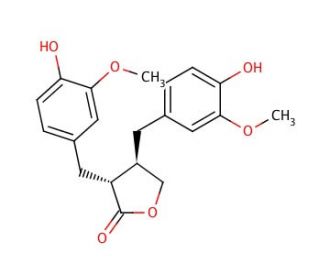

Matairesinol (CAS 580-72-3)
QUICK LINKS
Matairesinol, one of the principle lignands present in dietary fiber, undergoes metabolism by enteric bacteria to yield enterolactone and enterodiol. The inverse association observed between serum enterolactone levels and serum isoprostane levels suggests a potential protective effect against oxidative injury. Furthermore, Matairesinol acts as an inhibitor of Mdr-1. This naturally occurring phytochemical is abundantly present in the bark and needles of various coniferous trees. Classified as a lignan, which falls under the category of polyphenols. Although the exact mechanism of action remains partially elusive, Matairesinol is believed to function as an antioxidant, effectively scavenging free radicals and mitigating oxidative stress. It is also considered to possess anti-inflammatory properties, which contribute to the reduction of inflammation and promotion of healing processes. Additionally, Matairesinol is recognized for its potential as a neuroprotective agent, shielding neurons from damage and fostering optimal neurological function. The diverse range of biochemical and physiological effects attributed to Matairesinol encompasses the reduction of oxidative stress, mitigation of inflammation, and safeguarding neurons against harm.
Matairesinol (CAS 580-72-3) References
- Studies on the metabolism of the plant lignans secoisolariciresinol and matairesinol. | Niemeyer, HB., et al. 2003. J Agric Food Chem. 51: 6317-25. PMID: 14518962
- Radical and superoxide scavenging activities of matairesinol and oxidized matairesinol. | Yamauchi, S., et al. 2006. Biosci Biotechnol Biochem. 70: 1934-40. PMID: 16926506
- Secoisolariciresinol and matairesinol of sea buckthorn (Hippophaë rhamnoides L.) berries of different subspecies and harvesting times. | Yang, B., et al. 2006. J Agric Food Chem. 54: 8065-70. PMID: 17032010
- Immunomodulatory effect of (--)-matairesinol in vivo and ex vivo. | Yamawaki, M., et al. 2011. Biosci Biotechnol Biochem. 75: 859-63. PMID: 21597179
- Matairesinol inhibits angiogenesis via suppression of mitochondrial reactive oxygen species. | Lee, B., et al. 2012. Biochem Biophys Res Commun. 421: 76-80. PMID: 22483751
- Cytotoxicity of arctigenin and matairesinol against the T-cell lymphoma cell line CCRF-CEM. | Su, S., et al. 2015. J Pharm Pharmacol. 67: 1316-23. PMID: 25922263
- Forsythia suspensa fruit extracts and the constituent matairesinol confer anti-allergic effects in an allergic dermatitis mouse model. | Sung, YY., et al. 2016. J Ethnopharmacol. 187: 49-56. PMID: 27085937
- Matairesinol Suppresses Neuroinflammation and Migration Associated with Src and ERK1/2-NF-κB Pathway in Activating BV2 Microglia. | Xu, P., et al. 2017. Neurochem Res. 42: 2850-2860. PMID: 28512713
- Matairesinol ameliorates experimental autoimmune uveitis by suppression of IRBP-specific Th17 cells. | Li, X., et al. 2020. J Neuroimmunol. 345: 577286. PMID: 32559555
- Matairesinol, an active constituent of HC9 polyherbal formulation, exhibits HDAC8 inhibitory and anticancer activity. | Mahajan, M., et al. 2021. Biophys Chem. 273: 106588. PMID: 33848944
- Effects of in vitro exposure of sheep ovarian tissue to zearalenone and matairesinol on preantral follicles. | Brito, DCC., et al. 2022. Zygote. 30: 419-422. PMID: 34689852
- Matairesinol exerts anti-inflammatory and antioxidant effects in sepsis-mediated brain injury by repressing the MAPK and NF-κB pathways through up-regulating AMPK. | Wu, Q., et al. 2021. Aging (Albany NY). 13: 23780-23795. PMID: 34705665
- Matairesinol Induces Mitochondrial Dysfunction and Exerts Synergistic Anticancer Effects with 5-Fluorouracil in Pancreatic Cancer Cells. | Lee, W., et al. 2022. Mar Drugs. 20: PMID: 35892941
- Matairesinol Nanoparticles Restore Chemosensitivity and Suppress Colorectal Cancer Progression in Preclinical Models: Role of Lipid Metabolism Reprogramming. | Wu, S., et al. 2023. Nano Lett. 23: 1970-1980. PMID: 36802650
Ordering Information
| Product Name | Catalog # | UNIT | Price | Qty | FAVORITES | |
Matairesinol, 1 mg | sc-205379 | 1 mg | $56.00 | |||
Matairesinol, 5 mg | sc-205379A | 5 mg | $170.00 | |||
Matairesinol, 25 mg | sc-205379B | 25 mg | $795.00 |
